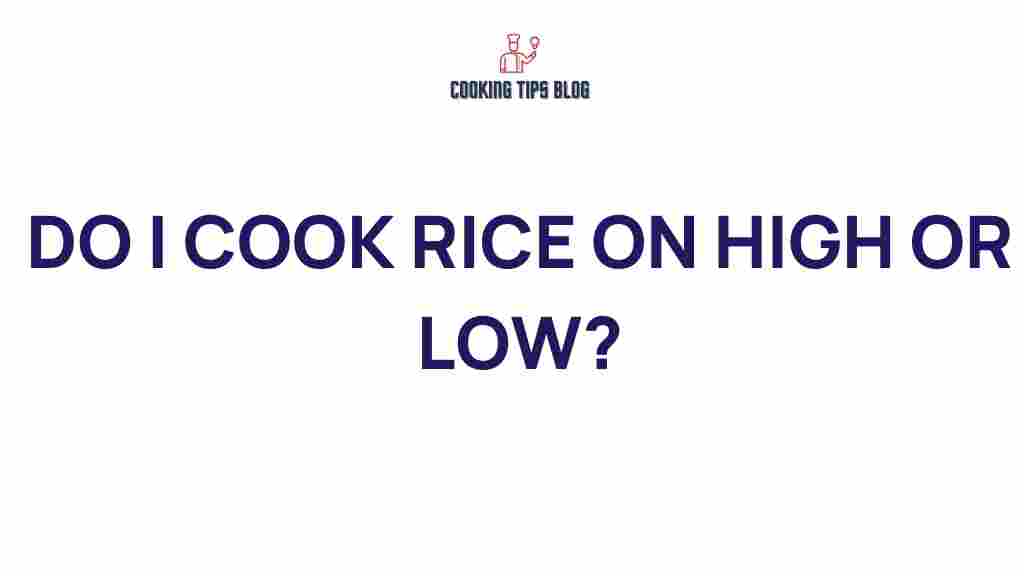The Secret to Perfectly Cooked Rice: High or Low Heat?
Cooking rice may seem simple, but achieving the perfect texture and flavor can be a challenge for many home cooks. The debate about whether to use high or low heat when cooking rice is a common one. In this article, we’ll explore the best methods for cooking rice, the science behind heat levels, and tips to troubleshoot common rice cooking issues. Let’s dive into the secrets of cooking rice to perfection!
Understanding Rice Types
Before we delve into the cooking techniques, it’s essential to understand the different types of rice. Each variety has unique characteristics that affect cooking times and methods. Here are some popular types:
- White Rice: The most common type, it cooks quickly and has a soft texture.
- Brown Rice: A whole grain option, it takes longer to cook and has a chewier texture.
- Jasmine Rice: A fragrant long-grain rice, popular in Asian cuisine.
- Basmati Rice: Known for its distinctive aroma and fluffy texture, often used in Indian dishes.
- Arborio Rice: Often used in risottos, it has a high starch content.
The Science of Cooking Rice
Cooking rice involves the absorption of water and the transformation of starches. The heat level plays a crucial role in how rice cooks:
- High Heat: Boiling the water rapidly can lead to uneven cooking if not managed properly.
- Low Heat: Simmering allows for even absorption of water and a more controlled cooking process.
The Best Method for Cooking Rice
Now that we understand the types of rice and the science behind cooking, let’s explore a step-by-step process to ensure perfectly cooked rice every time:
Step 1: Measure Your Rice
Start by measuring the amount of rice you want to cook. A standard serving is typically 1/4 cup of dry rice per person. Adjust accordingly based on your needs.
Step 2: Rinse the Rice
Rinse the rice under cold water to remove excess starch. This step is crucial for achieving fluffy rice rather than sticky rice. Rinse until the water runs clear.
Step 3: Determine the Water Ratio
The water-to-rice ratio varies depending on the type of rice:
- White Rice: 1 cup rice to 2 cups water
- Brown Rice: 1 cup rice to 2.5 cups water
- Jasmine Rice: 1 cup rice to 1.5 cups water
- Basmati Rice: 1 cup rice to 1.75 cups water
Step 4: Choose Your Heat Level
Here’s where the debate begins! Start by bringing the water to a boil over high heat. Once boiling, reduce the heat to low to cover and simmer the rice. This two-step process allows for rapid cooking initially, followed by even absorption.
Step 5: Cover and Cook
Cover the pot with a tight-fitting lid to trap steam. Cooking times vary, but generally:
- White Rice: 15-20 minutes
- Brown Rice: 40-45 minutes
- Jasmine Rice: 15-20 minutes
- Basmati Rice: 15-20 minutes
Step 6: Let it Rest
Once the cooking time is up, remove the pot from heat. Let it sit, covered, for an additional 5-10 minutes. This resting period allows the rice to finish cooking and helps with texture.
Step 7: Fluff and Serve
After resting, use a fork to fluff the rice gently. This step separates the grains for a light and fluffy texture.
Troubleshooting Common Rice Cooking Issues
Even with the best methods, issues may arise when cooking rice. Here are some common problems and their solutions:
- Rice is Too Sticky: This often results from not rinsing the rice or using too much water. Adjust your rinsing and water ratios next time.
- Rice is Undercooked: If the rice is crunchy or hard, it likely needs more water or time. Add a bit of water and return it to low heat with the lid on.
- Rice is Overcooked: If the rice is mushy, it may have absorbed too much water or cooked for too long. Next time, reduce the cooking time or water.
- Burnt Rice: This usually happens if the heat is too high. Always start high to boil, but reduce to low to simmer.
Additional Tips for Cooking Rice Perfectly
Here are some extra tips to enhance your rice cooking skills:
- Use a Heavy-Bottomed Pot: This helps distribute heat evenly, preventing hotspots that can burn the rice.
- Experiment with Broth: For added flavor, replace water with chicken or vegetable broth.
- Season the Water: Adding a pinch of salt to the water can enhance the flavor of the rice.
- Consider a Rice Cooker: If you frequently cook rice, investing in a rice cooker can simplify the process.
For more kitchen tips and techniques, check out this comprehensive guide on cooking techniques.
Conclusion
In conclusion, the secret to perfectly cooked rice lies in understanding the type of rice you’re using, the importance of rinsing, and mastering the heat levels during cooking. By starting with high heat to boil and then reducing to low heat for simmering, you will achieve fluffy and delicious rice every time. Remember to troubleshoot any issues as they arise and keep experimenting with flavors and techniques. Happy cooking!
For more information on different cooking methods, feel free to visit this informative site.
This article is in the category Tools and created by Cookingtipsblog Team
